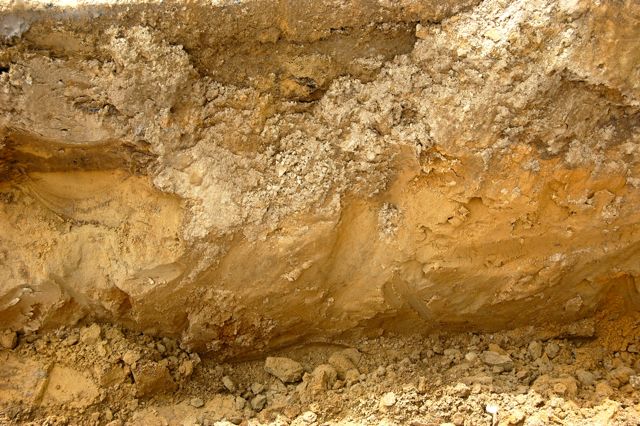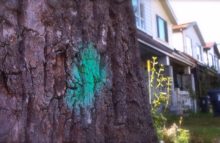Today’s headline is the punchline to the joke: Why will Toronto gardeners never go hungry?
The gas-main excavations in many Toronto neighbourhoods have been revealing. What they’ve revealed on our east-end, upper-upper-upper-upper-upper Beach street is sand, lots of deep, inert, yellow sand.
 This was the beach of prehistoric Lake Iroquois, making our street, which runs east and west at the top of the hill, former waterfront property.
This was the beach of prehistoric Lake Iroquois, making our street, which runs east and west at the top of the hill, former waterfront property.
Real estate prices were probably a lot lower 10,000 years ago.
When I took these shots, the excavator was curious. You wanna take a picture of a hole? When I explained my gardening interest, he said, Oh, yeah. It’s sand all over this area. But it makes it easier to dig. For him, maybe. We won’t mention the other thing I whinge about, but its initials are Norway maples.
I call sand “inert” above because, though it is mineral, it is very low in usable plant nutrients. Full of tiny hunks of rock, it’s almost a sterile medium, with nothing much for plants to eat. Plus, the large grains leave big gaps between them, supporting sieve-like drainage.
Some sandy areas of the city are luckier than others. They enjoy a sandy loam, which contains more organic matter and, therefore, more food for your flowers. Our area is sand on top of sand.
This is why we who garden on sand must be ever-vigilant about feeding the soil. I don’t mean feeding it liquid snacks of fertilizer, which is like drinking pop; a quick spike and then gone. With this underneath, you can see how quickly the watery stuff will drain away.
 I mean constant, regular additions of compost, manure and mulch. This is what lasts. It’s hard work, but somebody has to do it… and every year… if they want a garden.
I mean constant, regular additions of compost, manure and mulch. This is what lasts. It’s hard work, but somebody has to do it… and every year… if they want a garden.
Clay areas in the city have the opposite problem: clay soil is high in nutrients, but has poor drainage.
If you’re curious about what lies beneath your garden, you can download a Toronto soil map from this link. Some of the data was collected when the subway lines were constructed. It’s illuminating.
However, it might make you hungry for a sandwich.





7 comments
Helen, it sounds ridiculous to sound nostalgic for sandy soil, but I am. Early to warm up in the spring, easy to dig anytime, it definately has some benefits. The clay I am on now leaves me 6" taller when I try digging when it is wet, but if I wait till it is dry, well, I don't own a jackhammer! And don't get me started on the swamp it turns into after a heavy rain. The plus will be, when I can finally dig a hole in the ground, it should be fertile.
Deborah, You might enjoy reading the Canadian gardening classic "Tottering in My Garden" by Midge Ellis Keeble, which is funny as well as informative. One of the many things she struggled with in her various gardens was clay soil. I always think of her when I think of gardening on clay.
Helen, I did read "Tottering in My Garden". Actually, I was working for the newspaper in Orangeville, when the book was published and a friend of mine went to interview Midge. She and her husband lived just outside Orangeville, and apparently, she was even funnier in person.
On another note, would you find if I added your blog to my blogroll.
Deborah, Being added to your blog roll would be an honour and a privilege. If I could find a way to "follow" WordPress blogs, I would add you to my follow page. I have so many links down the right column, I've limited most of my "follows" (except non-Blogspots) to my profile page — or the column would stretch all the way to China.
How weird is that? I never considered the challenges of living where the soil is sand… it must be very tempting to truck in some loam or clay to mix with the sand and create a more balanced substrate.
OK, sounds as if there are many clay gardeners envying you your sand. Allow me to add my whinge to the collection; I garden with clay and decomposed granite; some of the granite is still quite composed, and needs large prybars or my Irish trenching spade.
Thought the story of Lake Iroquois and soil maps fascinating; it's great to know the geology and soils of our land. I'm still discovering unusual patches of soil in my area, after gardening there 30-plus years. Even some sandy soil – but not anywhere I garden.
Oooh, granite. Luxury!
It's always the way. I've wanted to have naturally curly hair all my life. You can see from our lettuce picture that mine is bone straight. (And my curly-haired friends want…)